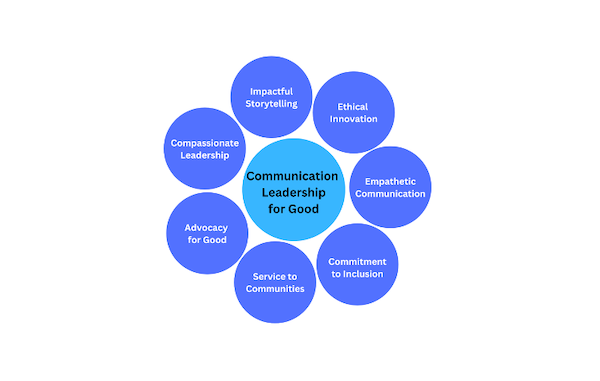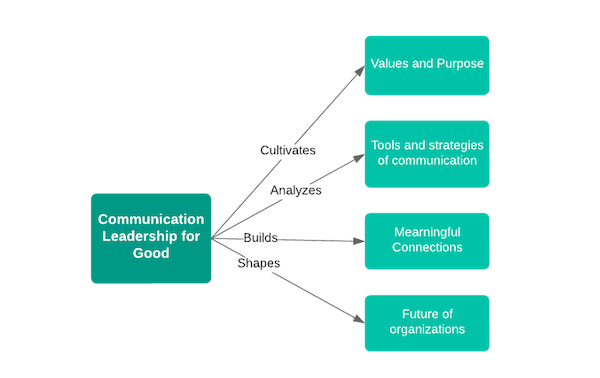Published on
Navigating Challenges Using Communication for Good
Ekin Yasin | Director of the Communication Leadership Program, University of Washington
Daniel Dolan | Professor of Professional Communication, Waseda University
2023 is rolling out some significant challenges. We face multiple crises including the pandemic, climate change, political unrest and related education reform pushes, the war in Ukraine and the devastating earthquake in Turkey. Add to that mix disruptive technological advancements in AI and their implications for academic and organizational learning at all levels. How will we respond?
Strong leadership and communication practices that break and prevent what The 2022 Edelman Trust Barometer calls the “cycle of distrust” are essential in navigating these challenges. We need communication leadership for good. Our Communication Leadership for Good model, as developed by the CommLead program at the University of Washington promotes honesty, integrity, equity and empirically verifiable facts through constant attention to seven foundational values.

We must acknowledge that communication and leadership can serve both positive and negative purposes. The recent rise of autocratic leaders and events such as the January 6, 2021, attack on the U.S. Capitol serve as poignant reminders of this fact.
A learning model centered on Communication Leadership for Good can guide us with purpose and equity despite the changing needs of work and society. This model is adaptable across global contexts and institutions, and we hope that this discussion inspires future initiatives in the higher education space. For example, Communication Leadership for Good master’s programs can emerge across institutions. Professional graduate programs could enhance their offerings with plug-and-play Communication Leadership for Good modules or certificates offered online or in a hybrid format.

Values Must Be at the Center of Everything We Do
The Communication Leadership for Good model places a strong emphasis on values that are central to the learning process and not just topics for discussion. The seven foundational values shown in our model are not prescribed but rather serve as aspirational possibilities. Students are given opportunities to define their own values and purpose and to put those values into action.
To build a values-driven community of practice, the program starts by asking the learning community to collectively articulate its values. This allows the broader community to define the program’s values, promoting a sense of collective responsibility and ownership. This process of articulating values should be iterative, taking place periodically to keep up with societal changes and priorities.
These values should also be integrated into all school and organizational training curricula, with an introductory course centered on these values being offered as a way to introduce students to related lived experiences and to develop the skills to articulate their own core values.
Throughout the learning experience, students are encouraged to build on their values by participating in applied learning with organizations working to do good in the community, contributing to their projects and identifying the social impact they want to make based on their values. This approach promotes the development of ethical leaders who lead with integrity, honesty, equity and facts.
Communication Tools and Strategies Are Ever-Changing, And We Need to Stay Up to Date
In leadership, effective communication is considered the cornerstone of success. It is through communication that leaders guide, motivate and build relationships with others, as well as share the process and outcome of decision-making. While the significance of communication in leadership may seem self-evident, we must emphasize its importance and recognize its central role in human interactions.
A communication leadership program must prioritize the development of key communication skills that are relevant to contemporary societies. This includes, but is not limited to, active listening, developing an inclusion mindset, effective crisis management and team leadership.
However, in today’s complex and rapidly evolving world, where communicative processes occur across various platforms and technologies, a mere understanding of communication practices is insufficient. It is imperative that the program’s model include a learning environment that analyzes and incorporates emerging tools and communication technologies. This enables students to gain a deeper understanding of how organizations communicate with stakeholders, how they adapt to changes in the digital media landscape and how they effectively communicate across different tools and technologies.
Meaningful Connections Lead to Strong Communities
The pandemic has highlighted the importance of meaningful connections in our lives. In response to this, the Communication Leadership for Good model shifts away from a purely transactional approach to one that prioritizes meaningful relationships. This is in line with the idea put forward by Mia Birdson in her book How We Show Up: Reclaiming Family, Friendship, and Community that we need to break away from toxic individualism that hinders deep connections and intimacy.
To build a program that places a strong emphasis on communication and leadership for good, a multifaceted approach is necessary. This includes incorporating the study of connections and relationships into the curriculum, as well as providing opportunities for students to connect and build relationships with each other. While undergraduate programs often focus on student engagement, professional and graduate programs often focus more on networking. However, Yale professor and author Marissa King believes that it is not the power of networking but actual networks that allow students to support each other. King writes: “The quality (not quantity) of your social connections is a strong predictor of your cognitive functioning, work resilience, and work engagement” (11). We propose that student engagement and experience matter at all levels of education.
However, merely fostering relationships among students is not enough to cultivate a focus on communication and leadership for good. Programs should also offer opportunities for students to put their learning into practice and make a positive impact in their communities. This can be achieved by including applied learning classes and supplementing the curriculum with initiatives that allow students to act on their values and build meaningful connections with local communities.
It Is Important to Understand What the Future Holds
We believe that the proposed Communication Leadership for Good learning model can develop values-driven, community-focused future leaders who are equipped with tools and practices of communication and responsive leadership that strategically position them to navigate challenges and make positive change in the world.
To what extent do you currently integrate the elements of the Communication Leadership for Good model into your programs? What are the prospects available at your educational institutions to incorporate the model? How can you equip your students with the necessary skills to develop a constructive outlook toward the future?
Let us break the cycle of mistrust with caring communities grounded in honesty and integrity and nourished by communication leadership for good.
References
Birdsong, M. (2020). How we show up: Reclaiming family, friendship, and community. Hachette Books.
King, M. (2022). In Social Chemistry: Decoding the patterns of human connection. Hodder & Stoughton.
2022 Edelman Trust Barometer. Edelman. (n.d.). Retrieved February 10, 2023, from https://www.edelman.com/trust/2022-trust-barometer
Author Perspective: Administrator



